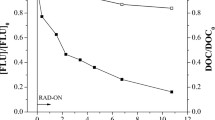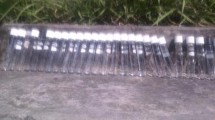Abstract
The effect of irradiation with visible light-emitting diode (LED) light on the efficiency of Fenton oxidation is investigated using phenol as the target compound (100 mg/L). The H2O2 dose and temperature are tested as operating variables with the aim of minimizing consumption of the reagents. At 50 °C, 10 mg/L Fe2+, and 60 % of the stoichiometric H2O2 amount, phenol was completely oxidized into CO2, H2O, and short chain organic acids, with oxalic acid completely degraded. Up to 95 % mineralization was achieved. This high efficiency can be attributed to the effect of LED radiation on the quinones/Fe2+/Fe3+/H2O2 cycle, which significantly increases the reaction rate, as well as on the photodecomposition of the iron complexes formed along the oxidation process, which also enhanced mineralization.







Similar content being viewed by others
References
Balmer ME, Sulzberger B (1999) Atrazine degradation in irradiated iron/oxalate systems: effects of pH and oxalate. Environ Sci Technol 33:2418–2424
Bautista P, Mohedano AF, Casas JA, Zazo JA, Rodriguez JJ (2008) An overview of the application of Fenton oxidation to industrial wastewaters treatment. J Chem Technol Biotechnol 83:1323–1338
Benkelberg HJ, Warneck P (1995) Photodecomposition of iron(iii) hydroxo and sulfato complexes in aqueous-solution—wavelength dependence of oh and So4-quantum yields. J Phys Chem 99:5214–5221
Chacón JM, Teresa Leal M, Sánchez M, Bandala ER (2006) Solar photocatalytic degradation of azo-dyes by photo-Fenton process. Dyes Pigments 69:144–150
Chen R, Pignatello JJ (1997) Role of quinone intermediates as electron shuttles in Fenton and photoassisted Fenton oxidation of aromatic compounds. Environ Sci Technol 31:2399–2406
Eisenberg GM (1943) Colorimetric determination of hydrogen peroxide. Ind Eng Chem , Anal Ed 15:327–328
García-Montaño J, Pérez-Estrada L, Oller I, Maldonado MI, Torrades F, Peral J (2008) Pilot plant scale reactive dyes degradation by solar photo-Fenton and biological processes. J Photochem Photobiol A 195:205–214
Jo W, Tayade RJ (2014) New generation energy-efficient light source for photocatalysis: LEDs for environmental applications. Ind Eng Chem Res 53:2073–2084
Kavitha V, Palanivelu K (2004) The role of ferrous ion in Fenton and photo-Fenton processes for the degradation of phenol. Chemosphere 55:1235–1243
Li Y, Jiang Y, Peng S, Jiang F (2010) Nitrogen-doped TiO2 modified with NH4F for efficient photocatalytic degradation of formaldehyde under blue light-emitting diodes. J Hazard Mater 182:90–96
Liu Y, Liu J, Lin Y, Zhang Y, Wei Y (2009) Simple fabrication and photocatalytic activity of S-doped TiO2 under low power LED visible light irradiation. Ceram Int 35:3061–3065
Mijangos F, Varona F, Villota N (2006) Changes in solution color during phenol oxidation by Fenton reagent. Environ Sci Technol 40:5538–5543
Munoz M, de Pedro ZM, Casas JA, Rodriguez JJ (2011) Assessment of generation of chlorinated byproducts upon Fenton-like oxidation of chlorophenols at different conditions. J Hazard Mater 190:993–1000
Ononye AI, McIntosh AR, Bolton JR (1986) Mechanism of the photochemistry of p-benzoquinone in aqueous solutions. 1. Spin trapping and flash photolysis electron paramagnetic resonance studies. J Phys Chem 90:6266–6270
Pignatello JJ (1992) Dark and photoassisted iron(3+)-catalyzed degradation of chlorophenoxy herbicides by hydrogen peroxide. Environ Sci Technol 26:944–951
Pliego G, Zazo JA, Pariente MI, Rodríguez I, Petre AL, Leton P, García J (2014a) Treatment of a wastewater from a pesticide manufacture by combined coagulation and Fenton oxidation. Environ Sci Pollut Res 21:12129–12134
Pliego G, Zazo JA, Casas JA, Rodriguez JJ (2014b) Fate of iron oxalates in aqueous solution: the role of temperature, iron species and dissolved oxygen. J Environ Chem Eng 2:2236–2241
Poerschmann J, Trommler U (2009) Pathways of advanced oxidation of phenol by Fenton’s reagent—identification of oxidative coupling intermediates by extractive acetylation. J Chromatogr A 1216:5570–5579
Pozdnyakov IP, Kel OV, Plyusnin VF, Grivin VP, Bazhin NM (2008) New insight into photochemistry of Ferrioxalate. J Phys Chem A 112:8316–8322
Sagawe G, Lehnard A, Lübber M, Bahnemann D (2001) The insulated solar Fenton hybrid process: fundamental investigations. Helv Chim Acta 84:3742–3759
Tokumura M, Znad HT, Kawase Y (2008) Decolorization of dark brown colored coffee effluent by solar photo-Fenton reaction: effect of solar light dose on decolorization kinetics. Water Res 42:4665–4673
von Sonntag C (2008) Advanced oxidation processes: mechanistic aspects. Water Sci Technol 58:1015–1021
Wang X, Lim T (2010) Solvothermal synthesis of C–N codoped TiO2 and photocatalytic evaluation for bisphenol a degradation using a visible-light irradiated LED photoreactor. Appl Catal B Environ 100:355–364
Wang P, Lim T (2012) Membrane vis-LED photoreactor for simultaneous penicillin G degradation and TiO2 separation. Water Res 46:1825–1837
Yin S, Liu B, Zhang P, Morikawa T, Yamanaka K, Sato T (2008) Photocatalytic oxidation of NOx under visible LED light irradiation over nitrogen-doped Titania particles with iron or platinum loading. J Phys Chem C 112:12425–12431
Zazo JA, Casas JA, Mohedano AF, Gilarranz MA, Rodriguez JJ (2005) Chemical pathway and kinetics of phenol oxidation by Fenton’s reagent. Environ Sci Technol 39:9295–9302
Zazo JA, Casas JA, Molina CB, Quintanilla A, Rodriguez JJ (2007) Evolution of ecotoxicity upon Fenton’s oxidation of phenol in water. Environ Sci Technol 41:7164–7170
Zazo JA, Pliego G, Blasco S, Casas JA, Rodriguez JJ (2011) Intensification of the Fenton process by increasing the temperature. Ind Eng Chem Res 50:866–870
Zuo YG, Hoigne J (1992) Formation of hydrogen-peroxide and depletion of oxalic-acid in atmospheric water by photolysis of iron(iii) Oxalato complexes. Environ Sci Technol 26:1014–1022
Acknowledgments
This research has been supported by the Spanish MICINN through the projects CTQ2013-41963-R and by the CM through the project S2013/MAE-2716. The authors also want to thank Dr. Harding for his collaboration.
Author information
Authors and Affiliations
Corresponding author
Additional information
Responsible editor: Vítor Pais Vilar
Rights and permissions
About this article
Cite this article
Pliego, G., Garcia-Muñoz, P., Zazo, J.A. et al. Improving the Fenton process by visible LED irradiation. Environ Sci Pollut Res 23, 23449–23455 (2016). https://doi.org/10.1007/s11356-016-7543-y
Received:
Accepted:
Published:
Issue Date:
DOI: https://doi.org/10.1007/s11356-016-7543-y




